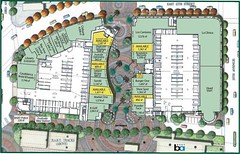Bitter Fruit in Fruitvale
![Fruitvale_TOD_pedestrian_only_street[2].jpg](http://static.flickr.com/39/85333408_e43d4b0a4e_m.jpg) Fruitvale retail at the BART Station, Oakland, California. A nice place to walk, if only it were better connected to the community outside, to better attract pedestrian shoppers. Photo from Laura Hall.
Fruitvale retail at the BART Station, Oakland, California. A nice place to walk, if only it were better connected to the community outside, to better attract pedestrian shoppers. Photo from Laura Hall.The Fruitvale transit-oriented-development project in Oakland, California is a poster child for LISC and Main Street (in terms of reaching out to Latinos), in particular the use of Main Street principles for commercial district revitalization in a more urban and majority-minority setting. The Fruitvale program was one of the demonstration projects in a joint Main Street Center-LISC project. LISC has since split off their effort into a separate "Center for Commercial Corridor Revitalization."
The Fruitvale story is also one of the case studies in Karl Seidman's Revitalizing Commerce for American Cities: A Practitioner’s Guide to Urban Main Street Programs.
The Eastbay Express, an alternative paper published in Oakland, California, reports in "Ghost Town: What if they built the development of the future and no one came?" that the Fruitvale project isn't faring too well, and that many of the retail businesses are failing.
 This site plan shows that the stores front on an exclusively pedestrian walkway, making this more of a pedestrian mall, but without reasons to attract pedestrian shoppers.
This site plan shows that the stores front on an exclusively pedestrian walkway, making this more of a pedestrian mall, but without reasons to attract pedestrian shoppers.Hindsight is a great thing and it's pretty easy to see what the problems are. First, there were but 47 residential units in the project. That's hardly enough to support the sale of a few cans of soda, let alone 22 new businesses. Second, the center is separated from the nearby and successfully Latino shopping center in traditional buildings.
Third, commuters often make lousy customers. They come and they go, and they don't buy very much in between. For example, how many commuter railroad stops are great retail centers? Fourth, the retail, in new buildings, must support high rents in comparison to the extant historic commercial buildings, and without high sales volumes, it can't work.

In short, between lack of sufficient residential density as well as significant urban design and connectedness issues, not to mention the disconnect in demographics between the area retail and the cost of renting in newly constructed buildings, this project, in and of itself, will have a difficult time succeeding, especially without the development of additional residential projects.
More (a lot more) residents to the area will support the development of more retail as well as a greater variety of types of stores, perhaps at different price points from those available currently.
It's important to learn the right lesson, that more residents and more connectedness are necessary to make retail development work, whether or not it is associated with transit.
Index Keywords: urban-revitalization



0 Comments:
Post a Comment
<< Home